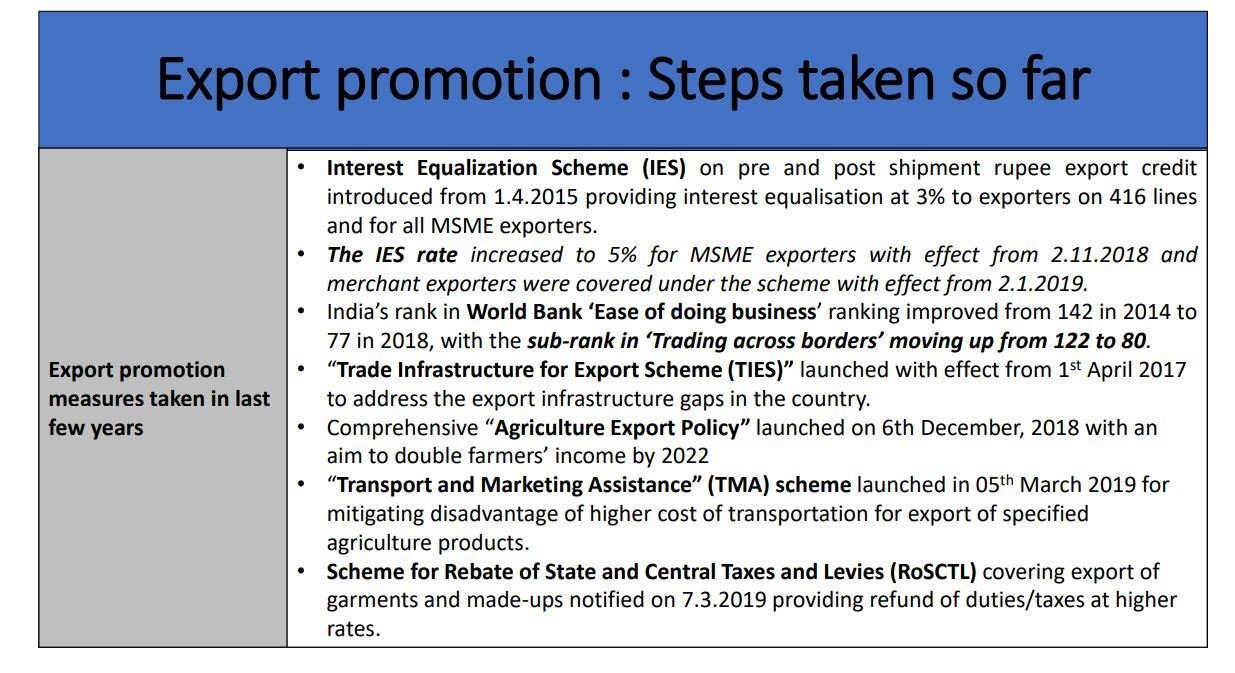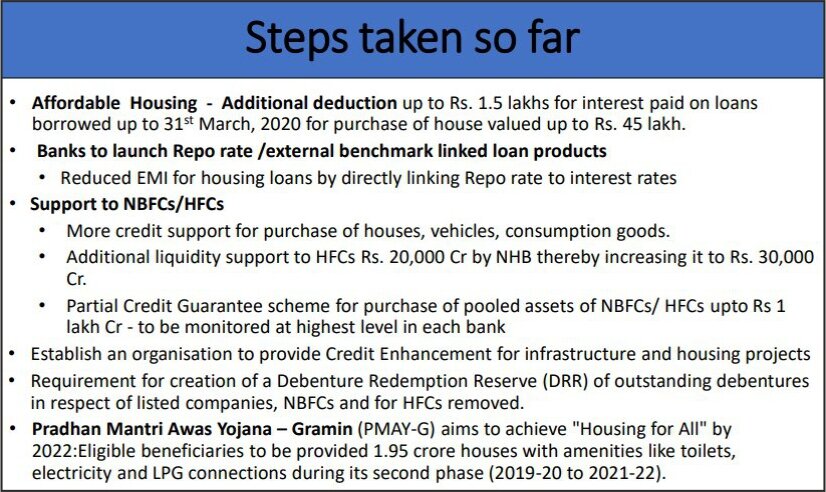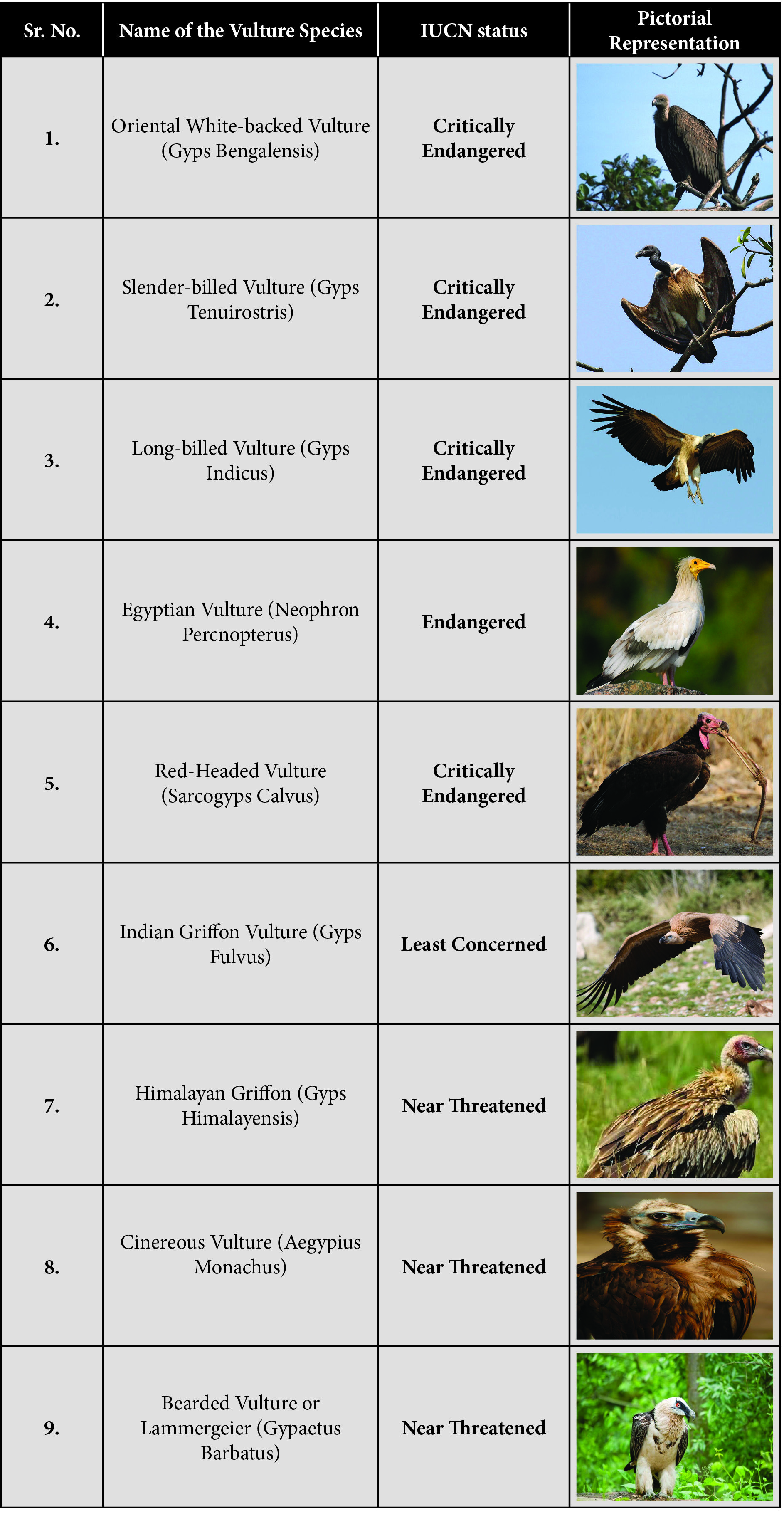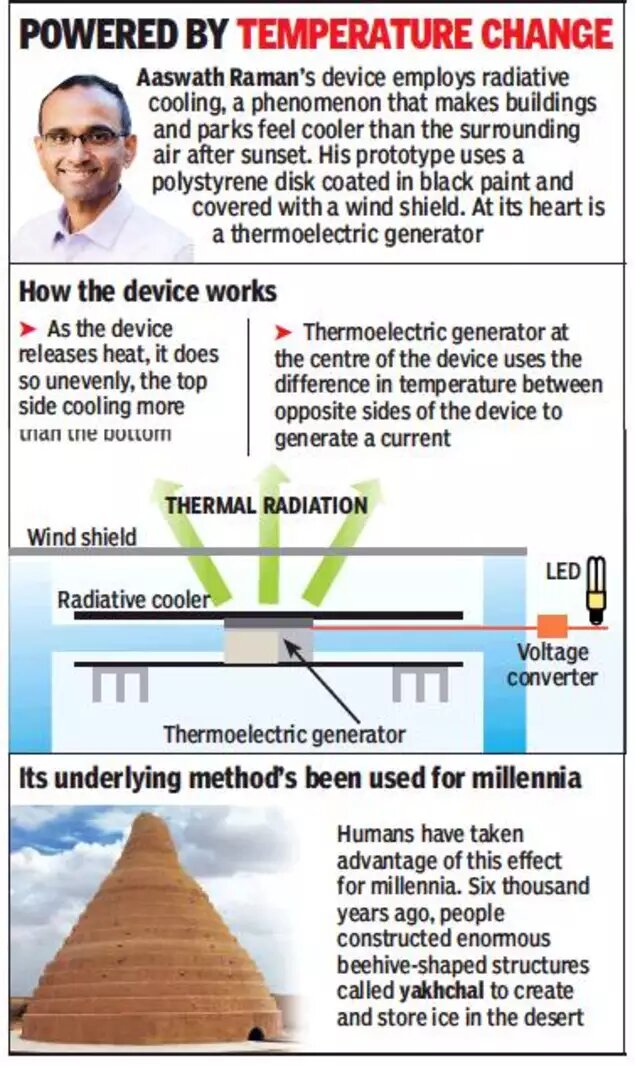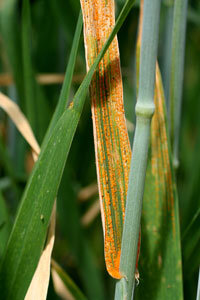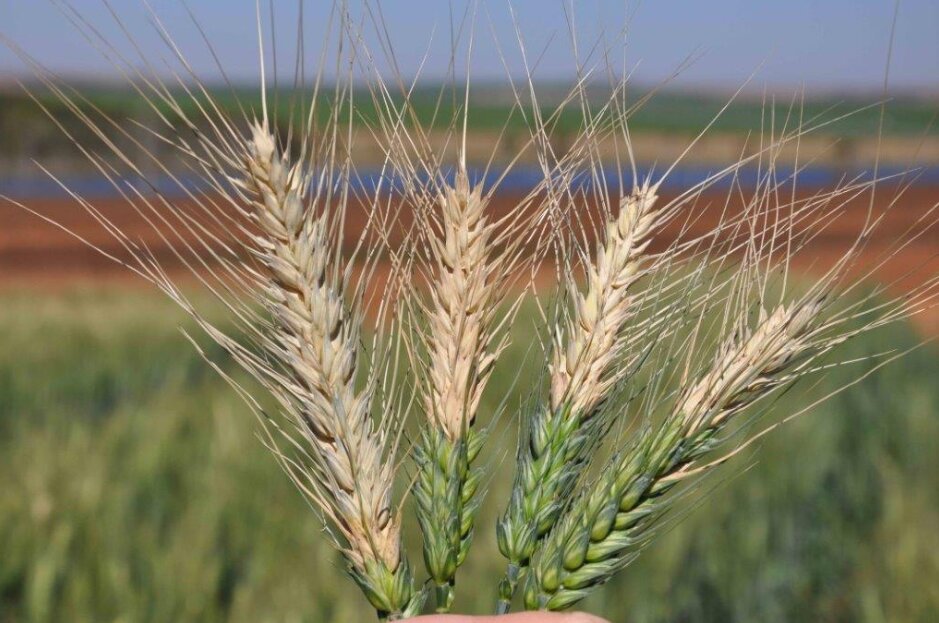Indian Economy
Steps To Spur Economic Growth
The Finance Minister has announced a number of measures to help reignite the slowing economy.
- The primary reasons for this slowdown include weak consumption (e.g. reduction in auto sales, housing sales etc.) and a deteriorating global environment (US-China trade war, Brexit etc.).
Measures To Boost Export Sector
- Use of Information and Communications Technology (ICT): Number of measures have been announced to leverage technology to promote exports.
- Fully electronic refund module for a quick and automated refund of Input Tax Credits (ITC) will be implemented by end September 2019.
- ITC means deducting the tax paid on inputs from the tax payable on the final output.
- An Online “Origin Management System” for exporters to enable them to obtain Certificates of Origin – CoO will be launched.
- Certificate of Origin is an instrument which establishes evidence on the origin of goods imported into any country. These certificates are essential for exporters to prove where their goods come from and therefore stake their claim to whatever benefits goods of Indian origin may be eligible for in the country of exports.
- Technology will be further leveraged to further reduce "Time to export" - through seamless process digitization of all export clearances (port/airport/customs, etc) and elimination of offline/manual services.
- Fully electronic refund module for a quick and automated refund of Input Tax Credits (ITC) will be implemented by end September 2019.
- Remission of Duties or Taxes on Export Product (RoDTEP): It will replace the Merchandise Exports from India Scheme (MEIS), which is not compliant with world trade rules.
- The new scheme will be implemented from 1st January 2020 and will more than adequately incentivize exporters than existing schemes put together.
- The Merchandise Exports from India Scheme (MEIS) was introduced in the Foreign Trade Policy (FTP) 2015-20 w.e.f. 1st April 2015 with the objective to offset infrastructural inefficiencies and associated costs involved in exporting goods/products which are produced /manufactured in India including products produced/manufactured by MSME Sector.
- Export Financing: To increase bank credit to exporters, the Export Credit Guarantee Corporation (ECGC) will expand the scope of its Export Credit Insurance Scheme (ECIS) to provide a higher insurance cover to banks that are lending working capital for exports.
- Credit flow to exporters has come down by 35%.
- At present banks are covered for 60% of what they lend to exporters for working capital. With the new move, it is expected to be increased to 90%.
- It would also enable a reduction in the overall cost of export credit including interest rates, especially to MSMEs.
- Effective monitoring of export financing will be done by the Department of Commerce.
- Export finance refers to financial assistance extended by banks and other financial institutions to businesses for the shipping of products outside a country or region.
- Priority Sector Lending (PSL) norms for export credit have been examined and enabling guidelines are under consideration of RBI.
- This will release an additional Rs. 36,000 - 68,000 crores as export credit under the priority sector.
- Effective Use of FTAs: Free Trade Agreement (FTA) Utilisation Mission, headed by a Senior officer in the Department of Commerce, will be set up, to work exclusively with export houses to utilise concessional tariffs in each FTA.
- Mega Shopping Festivals: To boost exports, Dubai- like annual mega shopping festivals in India will be organized in 4 places across March 2020. These will focus on four themes: Gems & Jewellery, Handicrafts/Yoga/Tourism, Textiles and Leather.
Measures To Boost Housing Sector
- Increasing Bank Credit for Homebuyers:
- The External Commercial Borrowing (ECB) guidelines will be relaxed to facilitate financing for home buyers who are eligible under the Pradhan Mantri Awas Yojana.
- The interest rate on house building advances will be lowered and linked with the 10 Year Government Security yields.
- A Special Window Fund, to provide last mile funding to non-NPA (Non-Performing Assets) and non- NCLT (National Company Law Tribunal) projects in the affordable and middle-income category.
- The government will contribute up to Rs 10,000 crores alongside other investors including LIC and private banks.
Biodiversity & Environment
Vulture Culture
India is home to nine species of vultures, but most of them face the danger of extinction.
The nine species of vultures & their International Union for Conservation of Nature (IUCN) status are:
Conservation Efforts
- To study the cause of deaths of vultures in India, a Vulture Care Centre (VCC) was set up at Pinjore, Haryana in 2001.
- Later in 2004, the VCC was upgraded to being the first Vulture Conservation and Breeding Centres (VCBC) in India.
- At present, there are nine Vulture Conservation and Breeding Centres (VCBC) in India, of which three are directly administered by the Bombay Natural History Society (BNHS).
- The main objective of the VCBCs was to look after the vultures and breed them in captivity and also release them into the wild.
- India’s conservation efforts are focussed on the three species of vultures which are Critically Endangered according to the International Union for Conservation of Nature (IUCN) namely,
- White-backed Vulture,
- Slender-billed Vulture, and
- Long-billed Vulture.
Reasons for Death of Vultures
- The major reason behind the vulture population getting nearly wiped out was the drug Diclofenac. It was found in the carcass of cattle on which the vultures feed.
- The drug was commonly administered to cattle to treat inflammation.
- Its veterinary use was banned in 2008 by the Government of India.
- Bioaccumulation (the gradual accumulation of substances, such as pesticides, or other chemicals in an organism) of Diclofenac caused kidney failure in Vultures, leading to death.
- Diclofenac is dangerously fatal for Vultures. Even 1% of it in carcass would kill the Vulture in a short time after it feeds such carcass.
- The poisoned carcasses were dumped to kill some local stray animals. But when vultures fed on them, it became one of the vital reasons leading to their death.
- It is imperative to manage our carcass dumps and make sure that poisoned carcasses are not dumped for the vultures to feed on.
- The forest department cremates the animal carcasses instead of burying them, to keep the poachers away. But this practice is denying food to vultures leading to their death out of starvation.
Way Forward
- The forest department needs to give emphasis on creating awareness and on creating safe zones for vultures in places where there is an existing vulture population.
- So far nine states have undertaken programmes to create safe habitats for vultures.
- Vultures are slow-breeding birds, there is a need for immediate intervention to save them from extinction.
Governance
Hindi Divas 2019
Rashtriya Hindi Divas is observed across India every year on 14th September.
- The Hindi language is the single largest spoken language (43.63% of people in India) among the 22 scheduled languages in the eighth schedule of the Indian constitution.
- It is also the fourth most spoken language in the world, after Mandarin, Spanish and English.
Background
- The Constituent Assembly of India adopted Hindi written in Devnagari Script along with English as the official language of the country on September 14, 1949, under Article 343(1).
- Initially, English was granted the official language status for only 15 years since the adoption of the constitution. During these 15 years, Hindi’s reach was to be promoted for official purposes as well as in the education sector so that English would fade out, giving ground to Hindi.
- Imposition of Hindi was contested in many non-Hindi states, especially in the southern state of Tamil Nadu. Violent protests broke out in southern India leading the then Prime Minister Jawaharlal Nehru, to introduce the ‘Official Languages Act’ in 1963, which assured the continuation of English along with Hindi as the official language of the Union of India.
- Anti-Hindi protests of 1965 marked an important turn in India’s official language policy. The ‘Official Languages Act’ was amended in 1967 guaranteeing the "virtual indefinite policy of bilingualism" for all official purposes of the Union.
- Given the linguistic diversity of India, there is no national language as all the states are free to decide their own official languages.
Constitutional Provisions
- Article 343(1) states that the Official Language of the Union government shall be Hindi in Devanagari script.
- Article 351 gives power to the Union Government to issue a directive for the development of the Hindi language.
- The Hindi language is one of the 22 languages of the Eighth Schedule of the Constitution of India.
Worldwide Promotion for the Hindi Language
- In 2018, the Indian Prime Minister became the first head of government to address the World Economic Forum in a national language other than English.
- The Government of India in collaboration with the Government of Mauritius has set up the World Hindi Secretariat in Port Louis, Mauritius for promotion and propagation of Hindi globally.
- Indian Government’s effort led to the creation of Hindi Twitter account of the UN in 2018.
- The first world World Hindi Conference was organized in Nagpur on January 10, 1975. To commemorate the occasion, the government of India since 2006 is celebrating 10th January as World Hindi Day.
- The then Minister of External Affairs Atal Bihari Vajpayee was first to give a speech in Hindi at the United Nations in 1977.
Science & Technology
Radiative Cooling & Electricity Generation
Recently, a scientist of Indian-origin has demonstrated a new way to generate electricity at night, without any active heat input.
- The prototype device employs radiative cooling, in which a sky-facing surface passes its heat to the atmosphere as thermal radiation, losing some heat to space and reaching a cooler temperature than the surrounding air.
- This phenomenon explains how frost forms on the grass during above-freezing nights, and the same principle can be used to generate electricity, harnessing temperature differences to produce renewable electricity at night, when lighting demand peaks.
- According to the laws of thermodynamics, everything on Earth emits heat.
- At night, when one side of Earth turns away from the sun, its buildings & streets cool off.
- If no clouds are present to trap warmth, objects on the Earth can lose so much heat that they reach a lower temperature than the air surrounding them.
- It can be noted that humans have taken advantage of this effect for millenniums.
- Six thousand years ago, people in Iran and Afghanistan constructed enormous beehive-shaped structures called Yakhchal, which used this passive cooling effect to create and store ice in the desert.
Working Principle
- This device releases the heat unevenly in a manner that the top side cooling is more than the bottom side cooling. It then converts the difference in heat into electricity.
- At its heart is the gadget called a thermoelectric generator, which uses the difference in temperature between opposite sides of the device to generate a current.
- When the device was connected to a voltage converter, it was able to power a white LED.
Potential Application
- This could be a broadly enabling approach to power generation suitable for remote locations, and anywhere where power generation at night is needed.
- While solar cells are an efficient source of renewable energy during the day, there is currently no similar renewable approach to generating power at night.
Way Forward
- Although the amount of electricity it generates per unit area remains relatively small, limiting its widespread applications for now, but the researchers predict it can be made twenty times more powerful with improved engineering -- such as by suppressing heat gain in the radiative cooling component to increase heat-exchange efficiency.
- If this device could produce any amount of electricity at night, it would be valuable as after the sun sets, solar cells don’t work and winds often die down. This innovation is vital in complementing other renewable sources of energy.
Important Facts For Prelims
World Ozone Day
Every year, 16th September is observed as the International Day for the Preservation of the Ozone layer.
- The theme for the year 2019 is ‘32 Years and Healing’.
- It celebrates over three decades of remarkable international cooperation to protect the ozone layer and the climate under the Montreal Protocol.
- It reminds that the world must keep up the momentum to ensure healthy people and a healthy planet.
- In 1994, the United Nations General Assembly proclaimed 16th September the International Day for the Preservation of the Ozone Layer, commemorating the date of the signing, in 1987, of the Montreal Protocol on Substances that Deplete the Ozone Layer.
- The Montreal Protocol has led to the phase-out of 99% of ozone-depleting chemicals in refrigerators, air-conditioners and many other products.
- The latest Scientific Assessment of Ozone Depletion completed in 2018, shows that parts of the ozone layer has recovered at a rate of 1-3% per decade since 2000.
- Ozone layer protection efforts have also contributed to the fight against climate change by averting an estimated 135 billion tonnes of carbon dioxide equivalent emissions, from 1990 to 2010.
Ozone
- Ozone (composed of three atoms of oxygen) occurs both in the Earth's upper atmosphere (stratosphere) and at ground level (troposphere). It can be good or bad, depending on where it is found.
- Good Ozone: Ozone occurs naturally in the Earth's upper atmosphere (Stratosphere) where it forms a protective layer that shields us from the sun's harmful ultraviolet rays.
- Bad Ozone: In the Earth's lower atmosphere (troposphere) near ground level, ozone is formed when pollutants emitted by cars, power plants, industrial boilers, refineries, chemical plants, and other sources react chemically in the presence of sunlight.
- Surface level ozone is a harmful air pollutant.
Important Facts For Prelims
Karan Vandana - A New Hybrid Wheat Variety
A new hybrid wheat variety Karan Vandana is soon to be launched across the country.
- It is also known as DBW-187.
- It is rich in protein and iron.
- It has high heat tolerance across the country.
- It is resistant to yellow rust and wheat blast which causes widespread losses.
- It will reduce unit costs for farmers as well as return higher yield than normal varieties.
- It can be cultivated only in areas under full irrigation support.
- It has been developed by the Indian Institute of Wheat and Barley Research (IIWBR) under the Indian Council of Agricultural Research (ICAR).
- Yellow rust is a fungal disease that manifests as powdery yellow stripes on leaves.
- These yellow stripes hinder photosynthesis and stunt the growth of the plant.
- Higher temperature combined with rains during wheat growing season aid the growth and spread of the disease.
- All the wheat-growing states like Punjab, Haryana, Himachal Pradesh, the Tarai region of Uttarakhand, Uttar Pradesh and the low lying areas of Jammu and Kashmir are susceptible to the disease.
- Wheat Blast is a fungal disease.
- It prevents maturation of the actual grain which affects reproduction by causing the host to produce fewer seeds.
- It can infect huge areas of cultivation resulting in more than 75% yield loss.
Important Facts For Prelims
Jaldoot
Jaldoot is a unique initiative that is designed to take the message of water conservation to masses.
- Regional Outreach Bureau (ROB under the Ministry of Information and Broadcasting), Pune in association with MSRTC (Maharashtra State Road Transport Corporation) is going to launch the Jaldoot campaign.
- The ROB has designed a bus to create the Jaldoot: A Travelling Exhibition on Jalshakti Abhiyan.
- The exhibition consists of various information display panels and audio-visual components.
- The Song & Drama Division cultural troupes and artists will travel along the bus to create awareness about the Government’s initiative.
- The bus will visit 8 districts of Maharashtra in the next 2 months.
- The field units at those locations will conduct different activities like competitions, rallies, cultural programmes, on the sidelines of the visit of the bus, in order to create awareness on water conservation efforts.
- To tackle the water crisis looming throughout the country, the Government of India launched the Jal Shakti Abhiyan in 2019.
- It is a water conservation campaign focusing on 1592 stressed blocks in 256 districts across the country.
Important Facts For Prelims
Birth Anniversary of M.Visvesvaraya
Every year India celebrates Engineer's Day on September 15, the birth anniversary of M.Visvesvaraya.
- He was an engineering pioneer of India whose genius reflected in harnessing of water resources and building and consolidation of dams across the country.
- He was the chief engineer responsible for the construction of the Krishna Raja Sagara Dam in Mysore.
- He was knighted as a Knight Commander of the British Indian Empire by King George V for his contributions to the public good in 1915.
- The design and patent of the automatic weir floodgates is also attributed to Sir M.Visvesvaraya.
- He was conferred India's highest honour, the Bharat Ratna in 1955.

